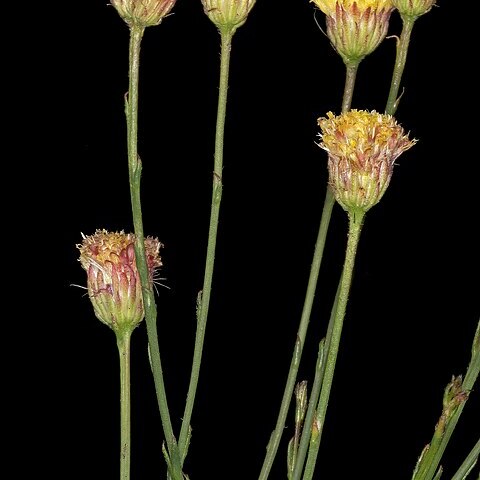Mostly inconspicuously leafy, erect, perennial herb or suffrutex, up to 0.45 m high, more prominently leafy in Mpumalanga and some KwaZulu-Natal specimens. Simple, annual stems arise from vertical underground rootstock, often purplish at base, sparsely branched in upper part, ribbed, often with embedded dark gland dots, spreading pubescent below, glabrescent to glabrous upwards, rarely with some glandular hairs as well. Leaves alternate, few, usually much shorter than internodes, appressed to stem, sessile, linear-triangular to linear, 2-20 (up to 35 mm in Mpumalanga specimens) x 0.5-1.0 mm; acute; broadened at base and semi-clasping; often folded lengthwise; margins entire, sometimes sparsely ciliate; mostly glabrous to sparsely spreading pubescent on lower surface, rarely with a few glandular hairs; with embedded gland dots on lower surface between midrib and margin. Capitula heterogamous, disciform, 10-12 mm in diameter, arranged in loose, terminal corymbs. Involucre campanulate. Involucral bracts arranged in 4 rows, imbricate, all with orange to almost black oil sacs along midrib, rarely without dark oil sacs, apices sometimes purplish, persistent after flowering, recurved; outer bracts narrowly ovate or narrowly obovate, 2 x ± 0.2-0.6 mm, acute to acuminate, with very narrowly membranous margin, spreading pubescent or glabrous; second row narrowly ovate or obovate, 2.5-4.0 x 0.5-1.0 mm, acute to acuminate, with narrowly membranous, fimbriate margin, spreading pubescent or glabrous; third row narrowly ovate to narrowly obovate, 3.2-6.0 x 0.8-1.4 mm, acute to acuminate, with broadly membranous, fimbriate margin, glabrous or with a few spreading hairs along the midrib; inner row narrowly obovate, 4.5-6.0 x 1.0-1.6 mm, acute, with broadly membranous, fimbriate margin, glabrous or with a few spreading hairs along the midrib. Receptacle epaleate, foveolate. Outer female florets 15-24, in 1 row, fertile, filiform; tube 1.5-2.0 mm long, with glandular hairs; 3-or 4-(5-)lobed, lobes much shorter than style furcation; corolla yellow. Style 2.4-3.0 mm long, bifurcate; style branches 0.5-0.8 mm long, apex rounded to acute; stigmatic areas along margin and confluent at apex. Cypsela and pappus as in disc florets. Disc florets 50-79, regular, bisexual, fertile; tubular below, widening slightly above, tube 2-3 mm long, with glandular hairs on lower half of tube, 5-lobed, lobes 1 mm long, often with dark lines (resin ducts) along margins; corolla yellow. Anthers 1.2-2.0 mm long; with ovate apical appendage, 0.5 mm long; base shortly caudate, ecalcarate; filament collars with thick-walled cells. Style 3.5-4.0 mm long, bifurcate; style branches 0.5-0.8 mm long, with deltoid-penicillate apical appendages; stigmatic areas along margins, not confluent at apex. Cypsela dark reddish brown with whitish, thickened margin, obovoid, laterally flattened, 2.0-3.5 x 1.0-1.5 mm; covered with twin hairs, often unequal, apices of hairs acute; epicarpic cells oblong, arranged in regular rows. Pappus bristles barbellate, in 1 row, 2.5-4.0 mm long.
More
Suffrutex or perennial herb, up to 450 mm high. Leaves alternate, distant, sessile; blade filiform, up to 20 x 1 mm, margins entire; glabrous. Heads disciform, solitary or in loose corymbs, terminal; peduncle glabrous. Involucral bracts 4-seriate, imbricate, with large, embedded, orange to almost black oil sacs, spreading-pubescent or glabrous. Flowers: outer female florets filiform, uniseriate, yellow; disc florets bisexual, yellow; Jan.-Apr. Fruit with cypsela obovoid, dull, dark reddish brown with whitish thickened margins, hairy; epicarpic cells oblong, arranged in regular rows. Pappus uniseriate, of barbellate bristles.
Simple or sparingly branched, erect suffrutex, up to 0.45 m high. Leaves alternate, entire, distant, filiform, < 1 mm wide, glabrous. Capitula disciform, solitary, terminal; involucral bracts with large, embedded, orange oil sacs. Ray florets female, in 1 row, filiform, yellow. Disc florets bisexual, tubular below, somewhat campanulate above, 5-lobed, yellow. Flowering time Sept. Pappus of barbellate bristles. Cypselae obovate, compressed, thinly appressed-pubescent.
Undershrub, up to 300 mm tall. Leaves distant, filiform, narrower than 1 mm, glabrous. Heads solitary, terminal. Involucral bracts with large embedded orange oil sacs. Flowers yellow.

